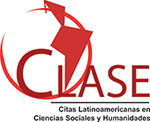Interacción Suelo – Estructura para edificaciones de hormigón armado, mediante modelos dinámicos
Palabras clave:
Interacción Suelo, Estructura, Modelos Dinámicos, Edificios, Evento símicoResumen
En este artículo, se desarrollará un análisis dinámico con interacción suelo-estructura en una zona de riesgo de la Provincia Francisco Orellana en Ecuador, a través de modelos dinámicos experimentales y la metodología ASCE 41-17, para conocer el comportamiento dinámico de edificios regulares de hormigón armado, con tipo de cimentación de zapatas aisladas. A través de esta metodología se pretende analizar la respuesta dinámica de estructuras de 3, 4 y 5 pisos; el estrato que se considera para el apoyo de cada edificación es una arcilla blanda. De acuerdo a la metodología propuesta se muestran fuerzas cortantes en la base, periodos de vibración, desplazamientos de techo y derivas de piso obtenidas como resultados. Una vez realizado el análisis, se aprecia variaciones en las características dinámicas de las estructuras tipo, teniendo mayor porcentaje de influencia, cuando se tiene la ocurrencia de eventos sísmicos ante mayor degradación del terreno.
Citas
Aguiar, R., & Ortiz, D. (2017). Analisis sismico de un edficio de 12 pisos de la ciudad de manta considerando interacciòn suelo estructura. Revista Internacional de Ingeniería De Estructuras., 22(3), 251–279. https://doi.org/http://dx.doi.org/10.24133/riie.v22i3.646
ASCE. (2017). Seismic evaluation and retrofit of existing buildings. ASCE/SEI 41-17, Reston, Virginia.
Butchibabu, B., Jha, P. C., Sandeep, N., & Sivaram, Y. V. (2023). Seismic refraction tomography using underwater and land based seismic data for evaluation of foundation of civil structures. Journal of Applied Geophysics, 210, 104934. https://doi.org/https://doi.org/10.1016/j.jappgeo.2023.104934
Forcellini, D. (2021). Analytical fragility curves of shallow-founded structures subjected to Soil-Structure Interaction (SSI) effects. Soil Dynamics and Earthquake Engineering, 141, 10. https://doi.org/https://doi.org/10.1016/j.soildyn.2020.106487
Gallegos Ortiz, B. (2015). Interaccion suelo estructura de Edificios, segùn Asce-10 y la guia Nerph-Nist-2012. 1, 3–4. https://doi.org/10.13140/RG.2.2.26875.77608
González Acosta, J. L., Vardon, P. J., & Hicks, M. A. (2021). Study of landslides and soil-structure interaction problems using the implicit material point method. Engineering Geology, 285. https://doi.org/https://doi.org/10.1016/j.enggeo.2021.106043
Hakam, A., & Suhelmidawati, E. (2013). Liquefaction Due to September 30th 2009 Earthquake in Padang. Procedia Engineering, 54, 140–146. https://doi.org/https://doi.org/10.1016/j.proeng.2013.03.013
Jiménez, C., Saavedra J., M., & Moreno, N. (2021). Seismic source characteristics of the 2016 Pedernales-Ecuador earthquake (Mw 7.8). Physics of the Earth and Planetary Interiors, 312, 106670. https://doi.org/https://doi.org/10.1016/j.pepi.2021.106670
Li, M., Lu, X., Lu, X., & Ye, L. (2014). Influence of soil–structure interaction on seismic collapse resistance of super-tall buildings. Journal of Rock Mechanics and Geotechnical Engineering, 6(5), 477–485. https://doi.org/https://doi.org/10.1016/j.jrmge.2014.04.006
Maquera, P. (2018). Isovalores de capacidad admisible del suelo para cimentaciones superficiales en el Sector Siete del Distrito Alto de la Alianza. REVISTA VERITAS ET SCIENTIA - UPT, 7(1), 848–858. https://doi.org/https://doi.org/10.47796/ves.v7i1.14
NEC. (2015). “PELIGRO SÍSMICO DISEÑO SISMO RESISTENTE”. Quito, Ecuador: Dirección de Comunicación Social, MIDUVI.
NEC-SE-GC. (2015). Norma Ecuatoriana de la Construcción, Geotecnia y Cimentaciones [Ecuadorian Construction, Geotechnics and Foundations Standard]. Recuperado de https://online.portoviejo.gob.ec/docs/nec6.pdf
NEHRP-NIST GCR 12-917-21,(2012), Soil-Structure Interaction Building Structures, Engineering Laboratory of the National Institute of Standards and Technology, Maryland.
Papadopoulos, M., Beeumen, R. Van, François, S., Degrande, G., & Lombaert, G. (2017). Computing the modal characteristics of structures considering soil-structure interaction effects. Procedia Engineering, 199, 2414–2419. https://doi.org/https://doi.org/10.1016/j.proeng.2017.09.296
Ruiz García, J., & Guerrero, H. (2017). Estimation of residual displacement ratios for simple structures built on soft-soil sites. Soil Dynamics and Earthquake Engineering, 100, 555–558. https://doi.org/https://doi.org/10.1016/j.soildyn.2017.07.008
Kleemann, J., Koo, H., Hensen, I., Mendieta-Leiva, G., Kahnt, B., Kurze, C., Inclan, D. J., Cuenca, P., Noh, J. K., Hoffmann, M. H., Factos, A., Lehnert, M., Lozano, P., & Fürst, C. (2022). Priorities of action and research for the protection of biodiversity and ecosystem services in continental Ecuador. Biological Conservation, 265, 109404. https://doi.org/https://doi.org/10.1016/j.biocon.2021.109404
Vicencio, F., & Alexander, N. A. (2021). Method to evaluate the dynamic structure-soil-structure interaction of 3-D buildings arrangement due to seismic excitation. Soil Dynamics and Earthquake Engineering, 141. https://doi.org/https://doi.org/10.1016/j.soildyn.2020.106494
Villarreal G., Cerna M., Espinoza C. (2021). Interacción sísmica sueloestructura en edificaciones con muros de ductilidad limitada sobre plateas de cimentación. Revista Internacional de Ingeniería de Estructuras, 26 (1),153-178
Villareal, G. (2020). Interacción suelo-estructura en edificaciones con zapatas aisladas. Revista Internacional de Ingeniería De Estructuras., 25(3), 311–332.
Vargas, Y. F., Pujades, L. G., Barbat, A. H., & Hurtado, J. E. (2013). Evaluación probabilista de la capacidad, fragilidad y daño sísmico de edificios de hormigón armado. Revista Internacional de Métodos Numéricos Para Cálculo y Diseño En Ingeniería, 29(2), 63–78. https://doi.org/https://doi.org/10.1016/j.rimni.2013.04.003
Wani, F. M., Vemuri, J., Rajaram, C., & Babu R, D. V. (2022). Effect of soil structure interaction on the dynamic response of reinforced concrete structures. Natural Hazards Research. https://doi.org/https://doi.org/10.1016/j.nhres.2022.11.002
Descargas
Publicado
Cómo citar
Número
Sección
Licencia
Derechos de autor 2022 Kevin Ricardo Proaño Viscarra , Luis Mario Almache Sánchez , Carlos Julio Cordero Cabrera

Esta obra está bajo una licencia internacional Creative Commons Atribución 4.0.
Authors retain copyright and guarantee the Journal the right to be the first publication of the work. These are covered by a Creative Commons (CC BY-NC-ND 4.0) license that allows others to share the work with an acknowledgment of the work authorship and the initial publication in this journal.






